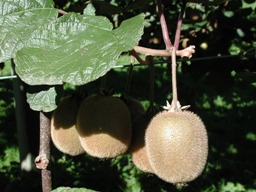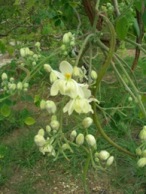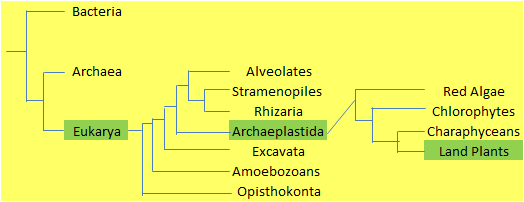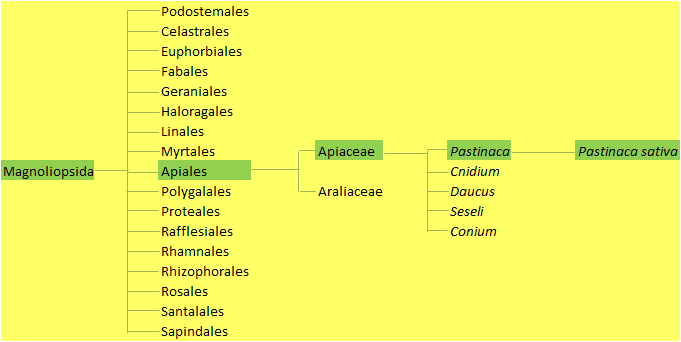How did I get here?!
Domain- Eukarya
Super-Group- Archaeplastida
Kingdom- Plantae (Land plants)
Sub-kingdom- Tracheobionta
Phylum- Magnoliophyta (Flowering plants)
Class- Magnoliopsida (Dicotyledons)
Order- Apiales
Family- Apiaceae (Carrot family)
Genus- Pastinaca (Parsnip)
Species- Pastinaca sativa
WHY am I a member of the Domain Eukarya?
Because my cells possess a true nucleus and membrane-bound
organelles! The alternative domains, Bacteria and Archaea, are
prokaryotic which means that their cells do not possess a true
nucleus. A few other eukaryotes are:
diatoms, amoebas, and
radiolarians.
WHY am I a member of the Super-group Archaeplastida?
Because I am photosynthetic and I exhibit an alternation of
generations of course! Other groups that are related to me
through this super-group are the red and green algae!
WHY am I a member of the Kingdom Plantae?
I am a proud member of the kingdom Plantae because, like my fellow
plants, I provide some sort of protection for my embryos.
Also, I exhibit an alternation of generations that includes both a
multicellular haploid and diploid phase in my life cycle.
Additionally, I have a cell wall, chloroplasts, and chlorophyll
which help me maintain my autotrophic life style! Liverworts,
horsetails and
licorice fern are also plants.

WHY am I a member of the Sub-kingdom Tracheobionta?
Because I am a vascular plant! I have special vascular tissue, xylem
and phloem, to help me transport things such as water and nutrients
throughout my entire body. A few other members of the
Tracheobionta include:
kiwifruits, ferns, and pine trees.
WHY am I a member of the Phylum Magnoliophyta?
You may have heard this phylum called the angiosperms. This
means that I am a flowering plant. I produce a fruit that
protects my ovaries and seeds, and I also have endosperm which is
nutritional tissue for my embryos. I have a seed coat and tough
leaves which makes me resistant to drought and cold. I usually
use insect pollination instead of wind pollination so I don’t have
to produce as much pollen to reproduce which saves me a lot of
energy! Many organisms are classified
as angiosperms ranging from delicate
daisies to the large box elder
trees.

WHY am I a member of the Class Magnoliopsida?
Because I am a dicotyledon! This means that my embryos have
two cotyledons and my seeds are sectioned down the middle and can be
split in half. My flower parts come in groups of fours or
fives, I possess a netlike leaf venation, and my primary vascular
bundles are arranged in a ring which allows me to have secondary
growth. Some other dicots are sunflowers, peas, roses and the
miracle tree.
WHY am I a member of the Order Apiales?
Because I have small, simple flowers that consist of one ovule for
each floral chamber, I can both self-pollinate and be pollinated by
several different organisms so I can be widely distributed. I
am one of about 3500-4000 species in this order.
Ginseng
is also in this order.

WHY am I a member of the Family Apiaceae?
My family may also be known as the Umbellferae. I fit perfectly
into this family because I have a hollow stem. I am an herbaceous
plant just like most of my relatives in the family. I usually
exhibit inflorescence (I have either a single or compound umbel)
because my flowers are so small that my pollinators might not even
notice me if my flowers weren’t grouped together! Some other
member of my family I’m sure you’ve heard of include:
dill,
celery, and fennel.
WHY am I a member of the Genus Pastinaca?
Because I am a parsnip! My species Pastinaca sativa is currently the
ONLY recognized species in the Pastinaca genus in North
America. I am known for my flattened fruits, and hundreds of
small yellow flowers. Even though you can’t tell at first
glance, I have a thick, funnel-shaped white taproot that can reach
up to 1.5 meters underground! Most parts of me are edible; you
can even eat my roots raw! My seeds can be used to make a
condiment and my leaves and stems can be used as a spice.
However, I am not harvested while I am in bloom.
HOW did I get my common name?
There are several different hypotheses of what my name literally
means. However, it is most likely that my genus Pastinaca is
derived from the Latin word pastus which means food. My
species sativa means “sown” in Latin, which indicates that I have
been cultivated. So, my name literally means cultivated
food. I also have many common names that different people like
to call me such as; parsnip, bird’s nest, hart’s-eye, heeltrot,
hockweed, madnip, queen weed, and tank. There are only
very obscure differences between me, wild parsnip, and cultivated
parsnip.
Trees!!

This phylogenetic tree begins at my domain and ends at my kingdom. This is a generalized tree that illustrates my oldest ancestors in the tree of life, originating with the eukarya. This tree was modified from Biology: Eight Edition (published by Campbell Reece), and is based on rRNA gene sequencing.

This phylogenetic tree illustrates the lineage of Pastinaca sativa from its class (magnoliopsida) all the way to its species (Pastinaca sativa). This tree was derived from the taxonomic hierarchy available on the USDA plants database. This taxonomy is mostly based on morphological characteristics, but also considers gene sequencing.
Check out my Habitat
Return Home

